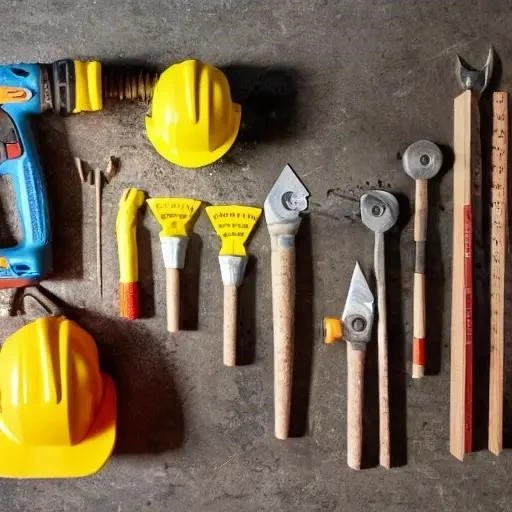
The skyline of tomorrow isn’t merely a vision; it’s a testament to human ingenuity, meticulously crafted by the hands of skilled professionals and, increasingly, empowered by an astonishing array of sophisticated tools. For centuries, construction has been a demanding endeavor, relying heavily on manual labor and brute force. Today, however, we stand at the precipice of a remarkable transformation, witnessing an unprecedented fusion of traditional craftsmanship with cutting-edge technology. This isn’t just about building faster or cheaper; it’s about constructing with unparalleled precision, safety, and an ecological consciousness that redefines the very essence of progress. The modern construction site, once a chaotic symphony of raw power, is evolving into a meticulously orchestrated ballet of advanced machinery and intelligent systems, promising a future where possibilities are only limited by our imagination.
Indeed, the days of rudimentary shovels and hand-cranked hoists as the primary arsenal are rapidly receding into history. Forward-thinking companies are recognizing that investing in the right equipment isn’t merely an expenditure but a strategic imperative, a catalyst for exponential growth and competitive advantage. By meticulously integrating insights from AI-driven analytics and embracing the palpable power of automation, construction sites worldwide are becoming bastions of efficiency and innovation. From towering cranes that effortlessly lift colossal beams to handheld devices that map entire structures with millimeter accuracy, the evolution of construction tools is dramatically reshaping the industry, propelling us toward an era of unprecedented productivity and architectural marvels.
| Category | Purpose & Importance | Key Examples | Future Trends & Innovations | Reference/Further Info |
|---|---|---|---|---|
| Heavy Machinery | Facilitates large-scale excavation, lifting, and material handling; crucial for foundation work and structural erection. | Excavators, Bulldozers, Cranes, Loaders, Graders, Forklifts. | Electric and autonomous machinery, AI-powered predictive maintenance, remote operation capabilities. | Caterpillar Inc. Official Site |
| Power Tools | Enhances efficiency and precision for cutting, drilling, fastening, and finishing tasks; reduces manual effort. | Drills (corded/cordless), Saws (circular, reciprocating, miter), Grinders, Nail Guns, Sanders, Jackhammers. | Battery technology advancements, smart tools with IoT connectivity, ergonomic designs to reduce fatigue; | DEWALT Official Site |
| Hand Tools | Fundamental for detailed work, measurement, adjustments, and situations where power tools are impractical. | Hammers, Wrenches, Pliers, Screwdrivers, Levels, Measuring Tapes, Utility Knives. | Advanced materials for durability, ergonomic handles, integrated digital displays for measurements. | Stanley Tools Official Site |
| Safety & PPE | Paramount for protecting workers from hazards, preventing injuries, and ensuring compliance with regulations. | Hard Hats, Safety Glasses, Gloves, Steel-toed Boots, Hearing Protection, Fall Protection Harnesses, First-Aid Kits. | Smart PPE with integrated sensors (detecting gas, impacts, falls), AI-driven hazard recognition systems. | OSHA Official Website |
| Surveying & Layout | Ensures accuracy in site preparation, foundation placement, and structural alignment; critical for precision. | Total Stations, GPS/GNSS Devices, Laser Levels, Theodolites, Measuring Wheels. | Drone-based photogrammetry, 3D laser scanning (LiDAR), augmented reality for on-site visualization. | Trimble Inc. Official Site |
| Advanced Technology | Drives innovation, enhances project management, improves data collection, and optimizes processes. | Building Information Modeling (BIM) Software, Drones, Robotics (for repetitive tasks), IoT Sensors, AI Platforms. | Fully autonomous construction robots, advanced material 3D printing, predictive analytics for project risks. | Autodesk Official Site (BIM) |
The sheer breadth of tools available today is staggering, each playing a distinctly crucial role in bringing architectural visions to life. Consider the gargantuan scale of heavy machinery: excavators meticulously sculpting the earth, bulldozers leveling vast expanses, and cranes gracefully hoisting multi-ton steel beams hundreds of feet into the air. These mechanical titans are the indispensable workhorses, dramatically accelerating foundational work and structural erection, making once impossible feats incredibly routine. Industry leaders, constantly striving for greater efficiency, are now pushing the boundaries with electric and even autonomous versions of these machines, promising quieter, cleaner, and ultimately safer job sites.
Beyond the colossal, an equally vital category comprises the ubiquitous power tools. From high-torque impact drills effortlessly boring through reinforced concrete to precision laser saws making impeccably clean cuts, these devices empower workers with enhanced strength and accuracy, significantly reducing the physical strain and time commitment of countless tasks. “The advent of cordless technology has truly liberated our workforce,” remarked a veteran project manager during a recent industry summit, “allowing unparalleled mobility and agility across dynamic environments. It’s a game-changer for productivity and safety alike.” By integrating IoT sensors, these smart tools can even provide real-time data on usage, maintenance needs, and performance, ushering in an era of proactive asset management.
Yet, amidst this technological surge, the humble hand tool retains its foundational importance. The carpenter’s hammer, the electrician’s pliers, the plumber’s wrench – these remain the core extensions of human skill, essential for intricate adjustments, detailed finishes, and situations where power tools are simply too cumbersome or powerful. Their enduring presence underscores a fundamental truth: technology augments, but it rarely entirely replaces, the nuanced touch of human expertise; Modern innovations in materials science and ergonomic design have continually refined these timeless implements, making them more durable, comfortable, and incredibly effective than ever before.
Perhaps the most critical “tool” on any construction site, though often overlooked in a purely mechanical sense, is comprehensive safety equipment. Hard hats, high-visibility vests, robust safety glasses, and fall protection harnesses are not mere accessories; they are non-negotiable lifelines. A truly forward-looking site prioritizes worker well-being above all else, understanding that a safe worker is a productive worker. Proactive safety measures, bolstered by regular training and advanced monitoring systems, cultivate a culture where hazards are identified and mitigated before they can cause harm. The future even envisions smart PPE, capable of detecting dangerous gases, alerting to potential falls, or monitoring vital signs, representing a profound leap in protective capabilities.
Looking ahead, the horizon of construction innovation gleams with unparalleled potential. Advanced technologies like Building Information Modeling (BIM) software, which creates comprehensive digital representations of structures, are revolutionizing planning and collaboration. Drones are now routinely deployed for site surveying, progress monitoring, and even material delivery, offering aerial perspectives and data collection capabilities that were once unimaginable. Robotics are emerging to tackle repetitive, hazardous, or precision-intensive tasks, from bricklaying to rebar tying. By integrating AI-driven insights, these tools can predict potential delays, optimize resource allocation, and even suggest design improvements, transforming project management from a reactive process into a profoundly predictive one.
Ultimately, the tools needed on a construction site today are far more than mere implements; they are the vibrant arteries of progress, pulsating with innovation and promising a future where our built environment is safer, more sustainable, and astonishingly efficient. Embracing this evolution is not just an option for construction firms; it’s an absolute necessity for those aspiring to lead the industry into its next golden age. The blueprints of tomorrow are not just being drawn; they are being dynamically assembled, piece by magnificent piece, by an extraordinary synergy of human skill and groundbreaking technology.
